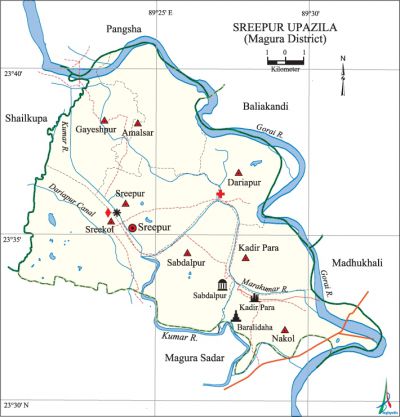Sreepur Upazila (Magura District)
Sreepur Upazila (magura district) area 179.18 sq km, located in between 23°32' and 23°41' north latitudes and in between 89°21' and 89°32' east longitudes. It is bounded by pangsha and baliakandi upazilas on the north, magura sadar upazila on the south, madhukhali and Baliakandi upazilas on the east, shailkupa upazila on the west.
Population Total 156401; male 78999, female 77402; Muslim 123281, Hindu 33038, Buddhist 71 and others 11.
Water bodies Main rivers: gorai, Kumar, Mara Kumar; Dariapur canal is notable.
Administration Sreepur Thana was formed in 1859 and it was turned into an upazila in 1983.
| Upazila | ||||||||
| Municipality | Union | Mouza | Village | Population | Density (per sq km) | Literacy rate (%) | ||
| Urban | Rural | Urban | Rural | |||||
|
- |
8 |
83 |
163 |
4282 |
152119 |
873 |
57.2 |
43.1 |
| Upazila Town | ||||||||
|
Area (sq km) |
Mouza |
Population |
Density (per sq km) |
Literacy rate (%) | ||||
|
3.11 |
2 |
4282 |
1377 |
57.2 | ||||
| Union | ||||
| Name of union and GO code | Area (acre) | Population | Literacy rate (%) | |
| Male | Female | |||
|
Amalsar 10 |
6419 |
12322 |
12061 |
31.27 |
|
Kadir Para 42 |
3766 |
7664 |
7569 |
49.50 |
|
Gayeshpur 31 |
5141 |
8935 |
8850 |
36.57 |
|
Dariapur 21 |
3522 |
7750 |
7813 |
47.06 |
|
Nakol 52 |
4764 |
9548 |
9199 |
49.59 |
|
Sreekol 73 |
7921 |
12148 |
11605 |
44.46 |
|
Sreepur 84 |
5361 |
10465 |
10262 |
45.21 |
|
Sabdalpur 63 |
6096 |
10167 |
10043 |
48.42 |
Source Bangladesh Population Census 2001, Bangladesh Bureau of Statistics.

Archaeological heritage and relics Ruins of the palace of Birat Raja, Radhanagar Neel Kuthi (Kadir Para), Buddha Sangharam, Peelkhana and the house of Munshi Gairatullah.
Religious institutions Mosque 115, temple 20, tomb 1. Noted religious institutions: Upazila Jami Mosque, tomb of Hazrat Pir Karim Shah Sabdalpur, Vedanta Math and Mission at Hazratala and Nakol Miapara, Kali Mandir at Baralidaha Paschim Para.
Literacy rate and educational institutions Average literacy 43.5%; male 47.3%, female 39.7%. Educational institutions: college 4, secondary school 26, primary school 71, kindergarten 3, community school 5, madrasa 16. Noted educational institutions: Nakol Raicharan Secondary School (1901), Sreepur MC Pilot Secondary School (1902).
Cultural organisations Library 1, club 23, cinema hall 4.
Main sources of income Agriculture 64.35%, non-agricultural labourer 2.07%, industry 1.50%, commerce 12.79%, transport and communication 4.72%, service 8.17%, construction 1.27%, religious service 0.15%, rent and remittance 0.62% and others 4.36%.
Ownership of agricultural land Landowner 61.19%, landless 38.81%; agricultural landowner: urban 61.71% and rural 61.17%.'
Main crops Paddy, jute, wheat, mustard, pulse, vegetables.
Extinct or nearly extinct crops Arahar, china, barley.
Main fruits Mango, jackfruit, coconut, litchi, banana.
Fisheries, dairies and poultries Fishery 45, dairy 40, poultry 15.
Communication facilities Pucca road 85 km, semi-pucca road 625 km, mud road 24 km; waterway 35 nautical miles.
Extinct or nearly extinct traditional transport Palanquin, horse carriage, bullock cart.
Noted manufactories Rice mill, ice factory, welding factory.
Cottage industries Blacksmith, potteries, weaving, bamboo work, cane work.
Hats, bazars and fairs Hats and bazars are 24, fairs 6, most noted of which are Amalsar Hat, Dariapur Hat, Gayeshpur Hat, Kadir Para Hat, Nakol Hat, Sabdalpur Hat, Sreekol Hat, Sreepur Hat and Charak Mela at Baralidaha.
Main exports Paddy, jute, banana, jackfruit.
Access to electricity All the unions of the upazila are under rural electrification net-work. However 16.95% of the dwelling households have access to electricity.
Sources of drinking water Tube-well 96.80%, tap 0.55%, pond 0.05% and others 2.60%.
Sanitation 19.19% (rural 18.29% and urban 50.98%) of dwelling households of the upazila use sanitary latrines and 60.73% (rural 61.35% and urban 38.99%) of dwelling households use non-sanitary latrines; 20.07% of households do not have latrine facilities.
Health centres Upazila health centre 1, family welfare centre 8.
Natural disasters Many people were victims of the cyclones of 1585 and 1909.
NGO activities Operationally important NGOs are brac, asa. [Md. Mohebbullah]
References Bangladesh Population Census 2001, Bangladesh Bureau of Statistics; Cultural survey report of Sreepur Upazila 2007.
